Longing for a foodie trip but travel isn’t an option right now? Don’t fret – whip up a few of these travel recipes and your gluttonous self will be thanking you during each and every bite.

I’m a girl that’s not ashamed to admit she enjoys her food. I sometimes even plan far-away international travel specifically for a few meals. Yes, I’m that girl. A foodie fanatic. I like food so much that I once scheduled a layover in Taipei just for some authentic xiao long bao. I mean, the beef noodle soup, bubble tea, and mango shave ice weren’t half bad either.
Nor was the ginger milk pudding in Hong Kong, daifuku in Japan, salt beef bagels and fish n chips in London, po boys in New Orleans, spanakopita and loukoumades in Greece, and poke in Hawaii (just to name a few). My to-eat list is typically just as long as my list of must-see attractions, hikes, and other travel activities. Ya feel me?
Since I don’t travel full time (nor would I actually want to – read more about me here), recreating travel experiences at home (see: travel-themed staycations) helps me get by until my next big adventure. And plus, I’m always craving/salivating after the flavors of elsewhere in the world. So why not learn how to make a few recipes inspired by my travels, I thought?
However (yes, of course there’s a however), I’m not the greatest cook (dun dun dun…). While I do love to indulge, I’m not one to attempt new recipes in the kitchen (I tend to stick to my regular made-a-million-times favorites). BUT I’m vowing to change that – starting today!
With that being said, I’ve asked a bunch of my travel and food blogging pals to share their favorite travel-inspired recipes from around the world. And there’s SO many good ones, I had to take out all the desserts and make a whole new post for them (coming soon). Put on your apron and pull out the pots and pans, we’re headed to Turkey, Canada, Bali, Belgium, and Gambia to name a few!
Travel Recipes From Around the World
Bosnian Cevapi | RECIPE

We first came across Cevapi (pronounced Che-Vah-Pee) in Bosnia as a quick street food bite. From the simple seasoning used and the way they were cooked so crispy on the outside and juicy on the inside had us ordering this dish again and again.
Cevapi is a simple Balkan Sausage recipe popular in Bosnia and Serbia. These homemade beef sausages are filled with delectable herbs and spices such as parsley, paprika, salt and pepper. One interesting fact is they use a baking soda mix that they knead into the meat to tenderize it.
You can also switch up the meat to be beef, pork, lamb or a combination of all three. It’s completely up to you! Beef is most popular, but different regions like to make up their own style. The taste is similar to a kofta kebab found in the Mediterranean regions like Greece.
They’re usually enjoyed on a nice hot summer day and best cooked on the barbecue or over a charcoal grill. You’ll find they’re most often served with ajvar – a red pepper based sauce, raw onion rings and fresh lapinja bread.
contributed by: Sarah and Laura from Wandercooks
Guatemalan Jocón de Pollo | RECIPE

One of the most beloved traditional dishes of Guatemala is Jocón, a savory chicken stew popular in the Mayan highlands around the cities of Quetzaltenango and Huehuetenango.
Although the recipe for Jocón de Pollo varies slightly within regions and among individual cooks, this emerald green dish almost always features an abundance of cilantro, green onion, tomatillos (also known as mil tomates) and green jalapeno peppers mixed with ground pepitoria (squash seeds) and sesame seeds.
It’s usually thickened with softened tortillas or masa so makes a hearty main course that’s especially welcome during the cool nights in the mountainous highlands. It’s generally served with rice, slices of avocado, tortillas de maize and wedges of lime. A shot of venado (local white rum) is a popular accompaniment.
contributed by: Michelle from A Taste of Travel
Spanish Paella Mixta | RECIPE
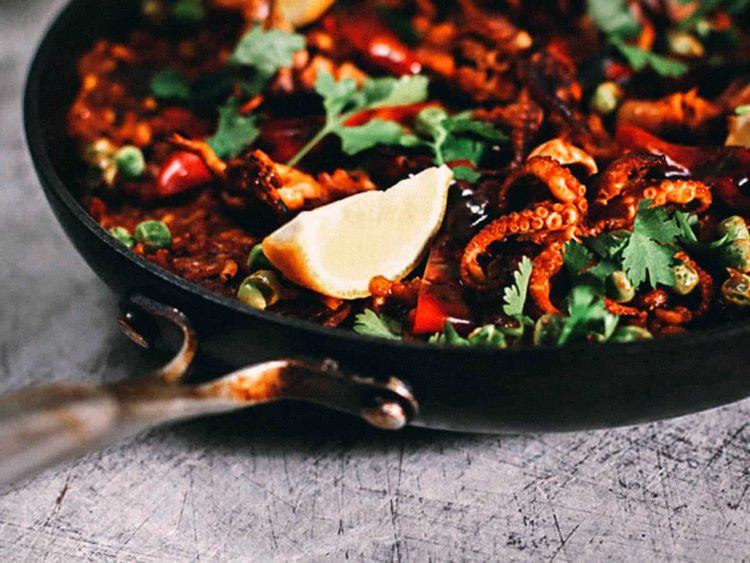
Paella is one of the most well-known Spanish dishes. Many people recognize it as a Spanish national dish but it has its roots in Valencia, where it’s considered a culinary symbol of the region.
In fact, Valencians are so proud and protective of paella that to them, it comes in just two forms – Paella Valenciana and Paella de Marisco. Anything else is considered inferior and inauthentic, and has no business being called a paella. Instead, they dismissively call any variations arroz con cosas, or “rice with things.”
One ingredient they take particular issue with is chorizo. For reasons I don’t understand, they believe chorizo has no business in any paella. This was surprising to me because I’ve found chorizo in almost every paella I’ve eaten outside of Spain.
Celebrity chefs like Jamie Oliver and Gordon Ramsay list chorizo as an ingredient in their paella recipes. So does Saveur Magazine. But for many Spanish people, not just Valencians, this is a big no-no. In fact, I heard Jamie Oliver received death threats for his chorizo-laden recipe for paella!
At the risk of getting shot, I present to you our version of paella mixta (mixed paella), made with octopus and *gasp* chorizo. But to Valencians and other Spanish people, this is a recipe for arroz con pulpo y chorizo. Whatever you call it, just call it delicious. Salud!
contributed by: JB from Will Fly for Food
Jordanian Tabbouleh | RECIPE

Most people have at least heard of tabbouleh, that deliciously fresh and earthy salad from the Middle East. Made with parsley, tomatoes, onions, bulgar, and mint -with a slightly citrusy dressing – this salad goes well with chicken, steak, pork, or seafood. It’s also wonderful all on its own as a vegan meal.
I learned to make this authentic version while taking a cooking class in Jordan at Petra Kitchen, and I’m betting it will be your new favorite side dish! This recipe is also wonderful the next day – so double the batch and serve it alongside a sandwich for lunch!
contributed by: Kelly from Food, Fun, and Faraway Places
Louisiana Style Jambalaya | RECIPE

Chicken, shrimp and sausage jambalaya is a simple, hearty Cajun dish that is full of authentic Louisiana flavor. It’s easy to make and perfect for feeding a crowd and celebrating Mardi Gras, no matter where you are in the world.
For all the flavor it has, jambalaya is a super simple one pot meal. You basically just keep adding things to the pot and you’ll have a beautiful, Cajun-flavored dish in about an hour!
The ingredients are mostly easy to find in any grocery store. Andouille sausage is a Cajun classic, but if your grocery store doesn’t carry it, you can substitute chorizo, kielbasa, or really any sausage you like.
A dutch oven is great for making jambalaya, but any heavy pot will work.
With lots of different kinds of protein, a little veg, some rice and lots of spices, it’s a flavorful meal the whole family will love.
contributed by: Ann from Our Happy Mess
Chinese Kung Pao Chicken | RECIPE
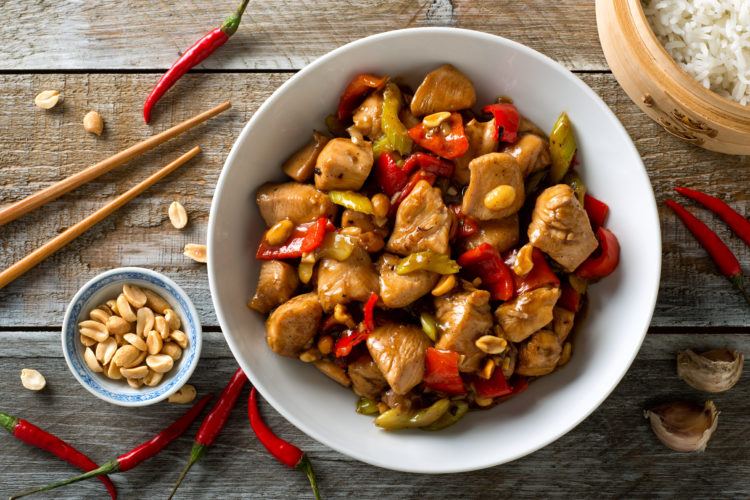
Kung Pao Chicken is an iconic Chinese dish that is known worldwide. But did you know that there are different styles of Kung Pao chicken, and that not all of them are spicy??
Traditional Sichuan Kung Pao chicken has been around for centuries, and, in fact, the dish was actually CREATED in the Sichuan province and is named after the province’s governor during the Qinq dynasty (mid-late 19th century). While most of the world knows Kung Pao chicken to be spicy, when prepared in Sichuan, the dish is actually sweet and savory, with a complex blend of flavors!
For the best taste, Sichuan Kung Pao Chicken is prepared with the regionally churned Sichuan soy sauce and chili paste, which have the distinctive flavor of the province. But thankfully, you can recreate the dish straight from home with the right ingredients!
Sichuan Kung Pao chicken features cubed chicken, as the main protein, as well as peanuts, spring onion, and rice wine to round out the flavor palate. It is best cooked in a wok, and only takes a quick ten minutes or so to make! It pairs well with steamed dumplings, white rice, pickled vegetables, and -of course- tea.
contributed by: Kay from the The Awkward Traveller
Braised Belgian Endives | RECIPE

The cultivation of endives, or ‘witloof’, or ‘chicons’ as they also call them in Belgium was discovered in 1830 by a Belgian farmer. Since then they have become a staple vegetable for many Belgian households, especially during winter time when endives are at their best quality. It’s such a versatile vegetable as it can be used to make soup, added raw to a salad, braised, fried and even eaten with pasta.
Belgian endives wrapped in a slice of ham then cooked in the oven with a bechamel sauce and grilled cheese on top is a classic Belgian dish. I’ve adjusted the recipe to make an easier to cook version of the classic dish for when you are craving a quick bowl of delicious comfort food.
My recipe is braised endives with bacon and a creamy cheese sauce. I used bacon bits to add extra saltiness to the dish and made a fast cheese sauce while cooking the endives. All of this can be made in one pan, which is great if you don’t feel like doing lots of dishes. This is one of my husband’s favorite meals, primarily for that reason.
contributed by: Sabine from The Tasty Chilli
Japanese Udon Noodles | RECIPE

Udon noodles originated in Japan and are beloved all over the world! [Editor’s Note: After visiting Tokyo a few times, I’m now obsessed with udon and go to my local noodle shop at least once a week to get a bowl]. They can be served hot or cold, depending on your taste. Udon are very thick wheat noodles that can take any dish to the next level. This udon noodle soup is inspired by the delicious Japanese noodle and is easy to make wherever you are in the world!
Thankfully, you can make the entire recipe using just one pot (hey there, easy clean up) and you don’t need anything special like a wok. You should have scallions, sesame oil, sweetener, and of course, the udon noodles, but otherwise, customizing the recipe to your tastes is so very easy. You can add a soft-boiled egg (a very popular addition) or the meat of your choice (pork is commonly used) if you’re feeling like you want to test out new flavors.
contributed by: Victoria from Wow It’s Veggie
Brazilian Coxinhas | RECIPE

Crunchy crust and hearty filling, coxinha tastes like more. Brazilian coxinha is a deep-fried croquette made of shredded chicken and cheese covered in a soft dough, which after breaded and deep-fried, becomes a crunchy crust. Will you resist?
This chicken croquette is a typical street food snack from Brazil that can be found in many sizes, from tiny cocktail bites to meal-sized snacks.
It is not a secret that Brazilian food is hearty and yummy, and thankfully, this croquette lives up to this fame. Beyond being a delicious street food snack, coxinha is also one of Brazilian’s favorite party and bar bites.
And if you want a few recommendations, know that coxinha tastes great with hot chili sauce. Even better when an ice-cold beer accompanies it! Oh, what a perfect combination!
So next time you want a delicious snack for holiday parties or barbecues with friends, add a tropical touch to the celebration and impress the crowds with this coxinha recipe. I’m sure you (and your guests) will love it.
contributed by: Bruna from I Heart Brazil
Zimbabwean Chakalaka | RECIPE
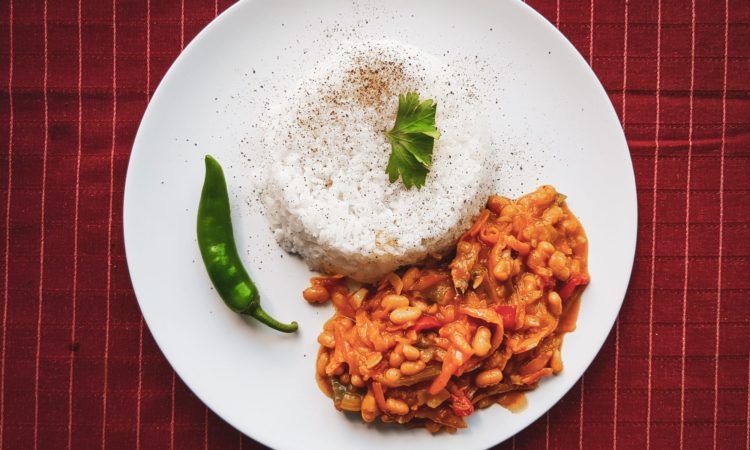
Chakalaka is a typical southern African dish that originated with Mozambique workers living in Johannesburg, South Africa, but it is now made in slight variations all over the southern part of the continent. This particular version is from Bulawayo, Zimbabwe.
Chakalaka is a spicy bean and veggie salad cooked so that the flavors meld into a relish that is sweet and savory at the same time and is packed with heat (though you can make it less pepper if you don’t like your food to be spicy).
For the veggies, you can use what you have on hand, but typical options include bell and scotch peppers, cabbage, and carrots. You can buy a chakalaka spice blend or make your own.
You can eat it with rice, which is easier to find around the world, but in Zimbabwe, its served with a maize porridge called pap.
Chakalaka can be eaten as a main dish with rice or pap, or as a side dish. It makes a delicious side to a meal of Peri-Peri chicken.
contributed by: Stephanie from The Africa Cookbook
Taiwanese Braised Beef Shank | RECIPE
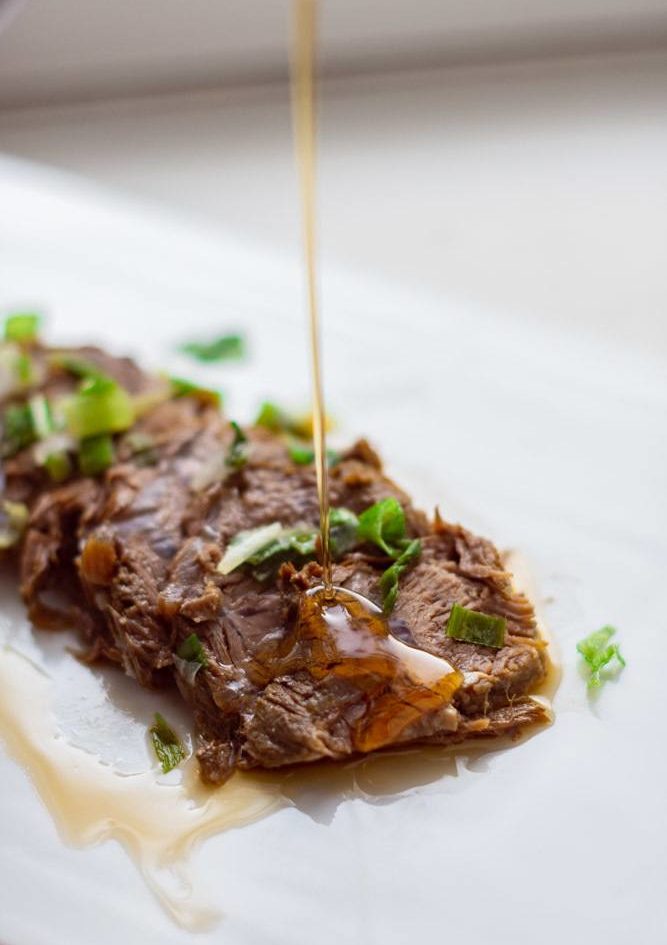
When I was little one of the many dishes my mom made that truly reminded me of Taiwan was braised beef shank. The 5 spice powder in this dish is what makes it quintessentially Taiwanese. Growing up in the USA for the majority of my life I always referred to it as Taiwanese Cold Beef because unlike most braised dishes, this one is served cold. The proper Chinese name is 卤牛肉, Lǔ niúròu or 卤牛腱子, Lǔ niú jiànz.
Beef is just one of the items you can braise using this method. Some other popular foods to braise using this method include chicken wings, drum sticks, seaweed knots (seaweed literally tied into knots), seasoned aged bean curd (tofu), and one of my all-time favorites, pig ears!
This dish is amazing served with some piping hot rice. And it’s a great item for a picnic. My mom used to make it for our beach trips and we’d have picnics on the beach, Taiwanese style!
And if you’ve ever attended a Chinese wedding banquet, this braised beef shank is one of the courses you would call an appetizer during the multi-course feast!
Now my mom of course still believes her original recipe is the best, but I’ve modernized it using the Instant Pot for quicker cook time and super tender beef.
contributed by: Diana from Sea of Blush
Spanish Boquerones al Limon | RECIPE
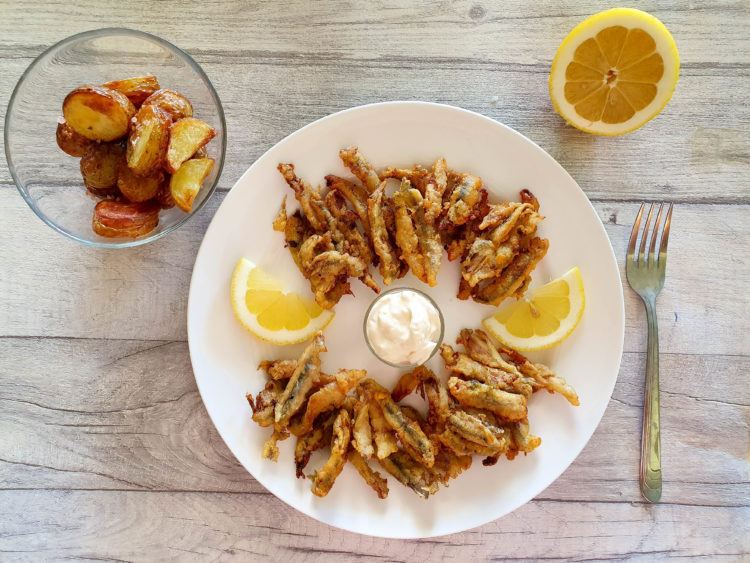
The “boqueron” is one of the most popular fish in the South of Spain, which became over the year a symbol of Malaga. There are festivals dedicated to the boqueron and the locals in Malaga proudly refer at themselves using the same name.
Boqueron is a type of anchovy, also known under the name of blue fish. There are over 140 different species of anchovies around the world, and boqueron is one of them. However, the boqueron that populates the Mediterranean Sea, in the South of Spain, is different. This type of anchovy is big, measuring between 9 and 12 centimetres long, characterised by being quite meaty. It has a distinctive flavour which is enhanced if prepared fresh – not like its anchovy relative, which is usually preserved in a jar.
In the South of Spain boquerones are very popular in the beach bars, as a tapa that accompanies beers, on hot summer days. They are either friend or marinated in vinegar. Boquerones al limon is a classic recipe in which the fish is cleaned, marinated in lemon for a couple of hours, and then deep fried in olive oil until it becomes golden and crispy.
No visit to Costa del Sol is complete without having boquerones at a chiringuito, on the beach.
contributed by: Joanna from The World in My Pocket
Nigerian Jollof Rice | RECIPE

Spiced and cooked in flavorful tomato and pepper purée, Nigerian jollof rice is a well-loved, classic West African versatile side dish that the whole family loves.
This yummy side dish easily becomes a one-pot meal by adding chicken. For a vegetarian version, add carrots, peas, and celery. Whichever way you make it, it provides a burst of flavor your whole family will love.
Jollof rice, one of the most common dishes in West Africa, goes perfectly with grilled beef, especially Nigerian suya kebabs, but it would complement any meat or fish. It’s savory and satisfying.
More economical versions of jollof rice are popularly referred to among Nigerians as “concoction rice,” the preparation of which can involve as little as rice and pepper.
Puréed vegetables flavor the rice but are not visible, thus making it a kid-friendly dish. Just adjust the spices for the heat level.
contributed by: Jas from All That Jas
Finnish Salmon Soup | RECIPE

Salmon Soup is a staple in Finland and other Scandinavian countries. In Finnish, salmon soup is called Lohikeitto and its traditionally made with salmon, leeks, and potatoes.
I first had this soup on a trip to Helsinki, Finland and its’ Vanha Kauppahalli, Old Market Hall. There were multiple food vendors selling traditional foods; fish, reindeer, lingonberries etc. I fell in love with the simplicity of this soup served with artisan bread.
Once I returned home, I recreated that salmon and potato soup to be a true taste of Helsinki. This is simple and so easy to make, which is exactly what you want in comfort food. Enjoy!
contributed by: Nicky from Little Family Adventure
Vietnamese Mango Salad | RECIPE
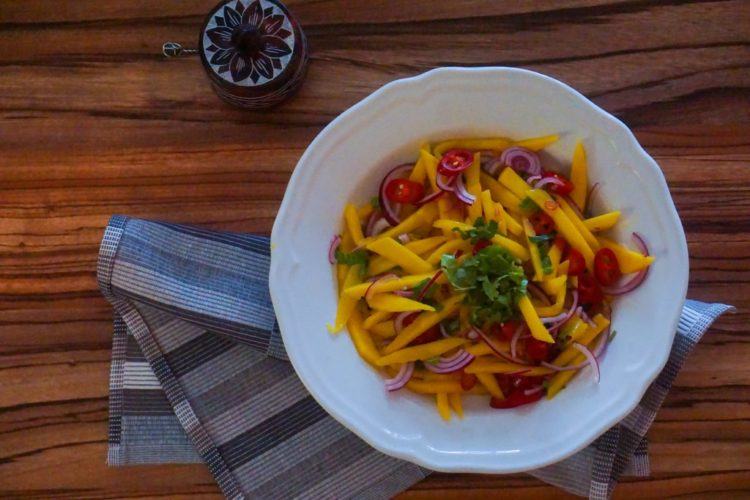
If you want a healthy and easy-to-make recipe to remind you of your travels to Vietnam, this mango salad is a tasty and simple way to transport you there through your tastebuds! I was taught this recipe by a Vietnamese expat living in Bulgaria, and it’s since become my go-to healthy side dish when preparing Asian inspired dishes.
While the recipe is pretty much identical to what you’d find in Vietnam, this recipe for Vietnamese mango salad uses a ripe yellow mango rather than an unripe green mango, which can be difficult to find outside of Asia or larger Asian grocery stores. However, the sweetness of the mango works perfectly with the spicy, tangy, and umami flavors of the dish — in fact, I may even like this variation a tad more than the original!
The dressing is made of lime juice, fish sauce, chili, and sugar. It’s mixed with small julienned strips of ripe mango (or unripe green mango works here too if you want to be closer to the original). Some punch is added to the salad with quick-pickled red onion, some fresh mint, and some roasted chopped peanuts for texture (optional).
contributed by: Allison from The Passport Kitchen
Filipino Lumpia | RECIPE

Filipino Lumpia are crispy, delicious egg rolls that are a traditional, popular dish served throughout the Philippines. Sometimes known as Lumpia Shanghai, these Filipino egg rolls are usually stuffed with a mix of well-seasoned ground beef, and a lot of chopped vegetables, including carrots, celery, mushrooms, and jicama.
Making them takes some time in prepping the vegetables, but once you have all of the ingredients ready to go, they are ready to assemble and cook up rather quickly. Lumpia are great finger foods making them perfect to serve at parties.
You’ll find most Filipinos serve these with every day meals, and most definitely at every single type of celebration or gathering of friends and family. These crispy, crunchy, hearty Filipino egg rolls are so delicious and they are always a crowd pleaser. Lumpia also freeze well and are great to make for snacks, lunch, dinner, or for last minute guests!
contributed by: Marlynn from Urban Bliss Life
Italian Ragu alla Bolognese | RECIPE

Bologna may be one of the oldest cities, and housing the oldest University in the world. Its old-world architecture and charm can be seen in every crook and corner, it’s amazing to walk around such a civilization. But what’s more amazing to look into is Bologna’s contribution to Italian cuisine. Ragù, the pasta sauce with chopped meat we love is a brainchild of Bologna’s Alberto Avisu. While we cook it quite fast at home, the original recipe takes about 6 hours from sauteing the ingredients until simmering and pouring over pasta.
Ragù alla bolognese is a dish particularly named after Bologna. Ragù or what we more commonly call bolognese sauce is served over thick pastas like tagliatelle, pappardelle, and fettuccine. No, not over spaghetti, but this is how most of the world has served it. While ragù alla bolognese can be a perfect meal all by itself, you can have arugula salad or insalata verde on the side and a glass of simple Sicilian red. Buon appetito!
contributed by: Gizelle from Kitchen Maus
Georgian Khinkali | RECIPE

One of the most iconic and sought after dishes in Georgian cuisine is khinkali — large soup dumplings with an array of fillings. Traditionally hailing from some mountain villages in the Caucasus, khinkali can now be found virtually everywhere in the country and are a favourite dish to eat amongst tourists and locals alike.
The most traditional of khinkali are filled with a spiced mixture of minced pork and beef that isn’t shy on the coriander or the caraway, however, khinkali with a mushroom are also quite common and easy to find for a vegetarian or vegan option. And despite the fact that they may look complicated and involved, these dumplings are actually quite easy to make at home if you have the right khinkali recipe.
There is also a particular way to eat khinkali, and it isn’t with a knife and fork! These delicious dumplings are eaten as a finger food. You pick up the dumpling with one hand from the tip, take a small bite out of the bottom and suck out the soup, and then eat the khinkali in a few more bites. Make sure not to eat the tip you picked it up from – this is typically very doughy and not fully cooked.
So, if you want to experience one of the most famous and delicious Georgian dishes out there, you can’t go wrong with khinkali!
contributed by: Maggie from The World Was Here First
English Yorkshire Pudding | RECIPE

Yorkshire pudding was traditionally served as a starter to fill the diner up a little before the main course as meat was more expensive and scarcer. It was simply served with gravy made from the meat juices and thickened with flour. Now, we tend to serve it as an accompaniment as part of a Sunday roast dinner. Made from eggs, flour and milk, it puffs up in the oven to a lovely crisp consistency on top but a more stodgy doughy consistency on the bottom that soaks up the gravy giving it a lovely savoury finish.
The key thing when cooking your Yorkshires is to get a quality, heavy bottomed Yorkshire pudding tin. Add a good dollop of beef dripping for the most authentic pudding (you can of course use vegetable oil) and then heat the tin as hot as your oven will go. Once the dripping is so hot it is smoking, remove the tin from the oven and add your mix as quickly as possible so that the heat is retained before popping it back in the oven.
Depending on your oven the Yorkshires will take around 25-30 minutes. If you have a glass doored oven then keep an eye on them, but otherwise resist opening the oven door as the cooler air will stop them rising as much as they should. Finally, serve with roast beef, roast potatoes, vegetables and gravy for a fabulous traditional Sunday dinner.
contributed by: Nikki from Yorkshire Wonders
Peruvian Pollo a La Brasa | RECIPE
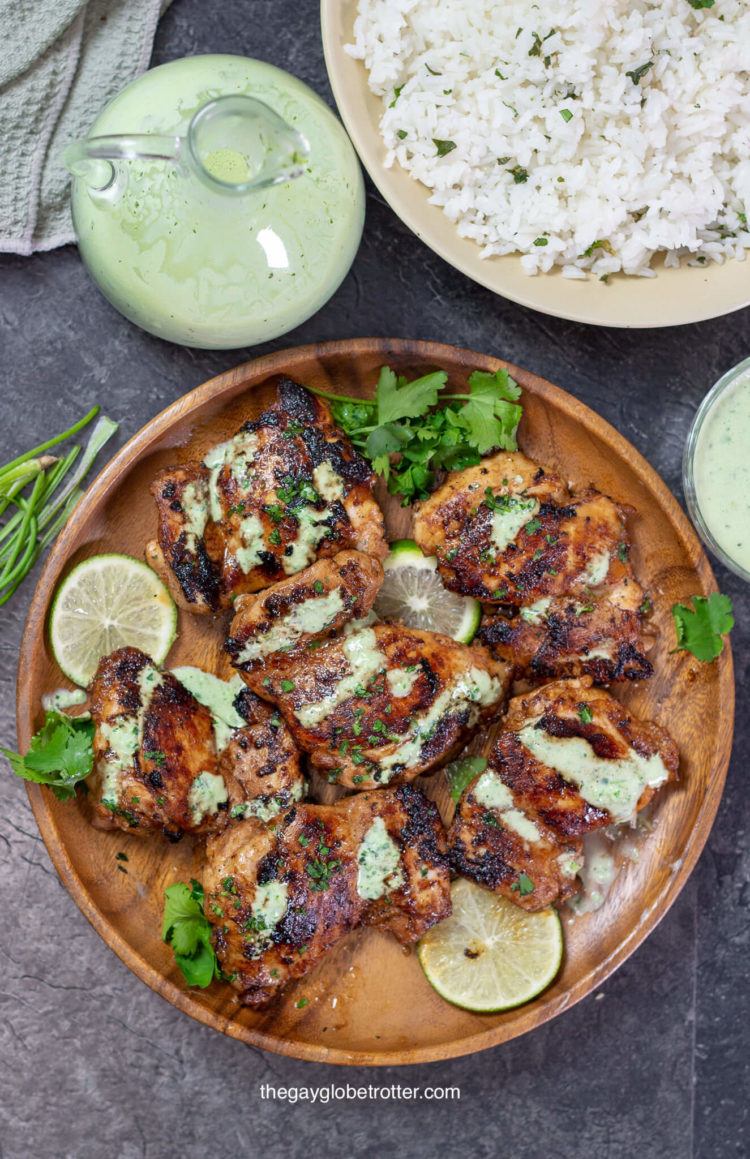
Peruvian Chicken, or ‘pollo a la brasa’ is a classic roasted chicken recipe popular throughout the country. Peruvian Chicken is marinated in a quick and easy marinade with ingredients like garlic, lime juice, cumin, and paprika then roasted until blackened.
Peruvian Chicken is classically served with a side of fresh lime and cilantro, as well as aji verde, or Peruvian green sauce which is a creamy, spicy sauce. This recipe works with just about any cut of chicken you have on hand, the cooking times will need to be adjusted to fit the chicken you are cooking. We love using dark meat, such as boneless skinless chicken thighs. Peruvian Chicken is best marinated overnight, but a minimum of 2 hours will work in a pinch!
contributed by: Bailey from The Gay Globetrotter
Moroccan Tagine | RECIPE

I first tasted tagine several years ago when I first visited Morocco. For Moroccans, tagine is their main dish that they make for almost every occasion. It’s the first type of meal young Moroccan women learn as the food they will feed their families, and I was astounded how many different varieties can be made. Tagine is kind of a stew that has its own type of vessel that it is traditionally made in, though you can also make it with a stockpot—no need to buy another item for your kitchen!
In fact, when you go to Morocco, you’ll see dozens upon dozens of tagine makers in the markets. You can also experiment a bit with the flavors if you like, and that’s all part of the fun. Feel free to add more cinnamon, sugar, and raisins if you would like a sweeter dish, or go heavy on the turmeric, saffron, and coriander for something more savory. You can also use pretty much all types of meat: traditionally, you’re most likely to find beef, chicken, and fish. However, it also makes an amazingly delicious veggie dish if you want to use squash or pumpkin as a substitute.
contributed by: Alex from Alex on the Map
Indian Chicken Korma | RECIPE

Chicken korma is an authentic gravy passed on from generations into our family. The dish is said to be originated in India in the Mughal era. Korma is basically a creamier and thicker version of curry. It is a creamy and rich dish full of spices and flavors accompanied with butter naan, parathas, or just simple jeera rice. We use both almonds and coconut to give it flavor and make it a thick gravy but you can either use one or both depending on your tastebuds. It really is a pretty versatile dish, meaning you can add or subtract ingredients as you like.
Chicken Korma isn’t as hard as you would think, as long as you have few basic Indian spices in your kitchen. It’s quick, easy, and almost a staple in every Indian household. We mostly find ourselves making a chicken and potato khurma with ghee rice which is an amazingly delicious combination! So, loosen your pants and try this delectable Indian recipe at home.
contributed by: Sarah from You Cook I Eat
Australian Mini Meat Pies | RECIPE

You cannot get more Aussie than this: meat pie is an iconic Australian
dish. You can get it almost anywhere and there are also specialised
shops that only sell pies! In fact, they are possibly the go-to lunch
for the majority of people on the move. Isn’t a juicy pie so much better
than your usual dry sandwich anyway?
Pies can be made with different fillings: minced beef, chopped chuck
steak, chicken and mushrooms… and these are only some of the most
popular varieties. Mince works best for smaller pies, while chunkier
pieces of meat are better for larger pies.
To get the “perfect” pie, you will need two different pastries:
shortcrust for a tender base and puff pastry for a crispy top. Meat pies
are to be served with tomato sauce – yes, that’s how we call ketchup
down-under! If you intend to serve them as a main dish make sure to have
mash and peas to go with them for the perfect Aussie meal.
contributed by: Manu from Manus Menu
Greek Meatballs (Keftedes) | RECIPE
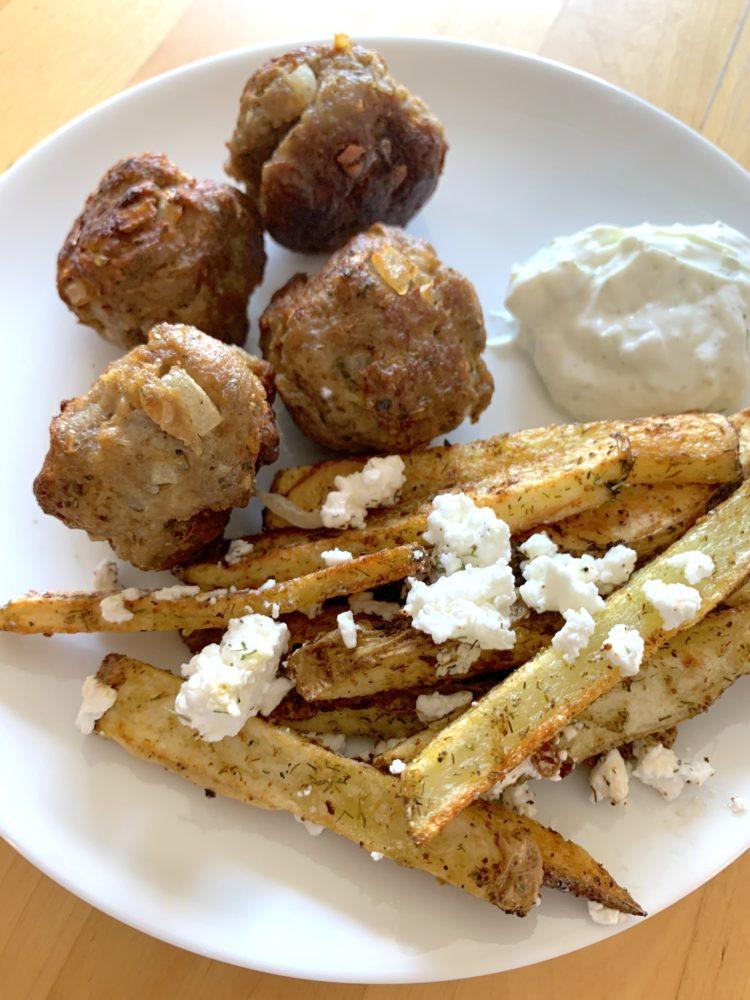
One of the wonderful things about visiting Greece is all the wonderful food. It’s wonderful to bring a taste of a destination back to your own kitchen. These simple to make Greek meatballs are the perfect way to do just that.
Keftedes is one of our favorite traditional Greek dishes. These tasty Greek meatballs are comfort food that our family has enjoyed over and over again. Every Greek home has a slightly different spice mix for Greek meatballs you are free to make them any way you like. Use whatever you have in your pantry to create a wonderful Greek meal.
Another great thing about Keftedes is that you can serve them at any mealtime breakfast, lunch or dinner. They pair perfectly with pasta, rice or potatoes to create a perfect homemade Greek meal.
contributed by: Sue from Food Travelist
Canadian Tourtiere | RECIPE

Tourtiere is a French Canadian meat pie originating in Quebec. It is served during the Christmas holidays, traditionally on Christmas Eve. Originally it was made with pheasant, rabbit, moose or pigeon. Now a days it is made with a combination of ground meats, the most common being pork, beef and veal.
Along Canada’s coast you can also find it made with salmon and trout. The key is the secret spice blend. Like most traditions, families do not like to share their sacred family recipe.
The just of the blend includes cinnamon, cloves, allspice and nutmeg.
This is a double crusted meat pie that is very heavy and rich. You only need a small slice. Perfect sides to accompany this meat laden dish are pickles, relishes, homemade ketchup and salad.
You can buy tourtiere at the grocery stores during the holiday season. Some markets will have them as well. Most often they are fresh. They can be frozen after cooking, and leftovers are always delicious.
contributed by: Gloria from Handmade and Yummy
Filipino Chicken Adobo | RECIPE
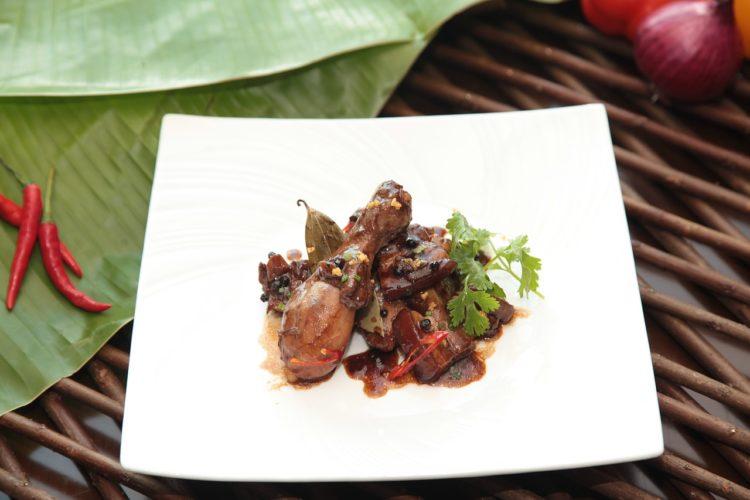
One of the most iconic of Filipino comfort foods is the very popular chicken adobo which is a favorite throughout the country with everyone doing different variations of this national dish.
Made mostly with garlic, vinegar and soy sauce, this dish is relatively easy and fast to do and you can use any chicken part. BUT the most flavorful are the dark meats with thighs and drumstick being the favorite meats to use in this mouth watering dish. Combined with a nice scoop of rice and you’ll see why you can’t get enough of this delicious comfort food that is also very easy to make.
contributed by: Noel from This Hawaii Life
Scottish Northumbrian Broth | RECIPE
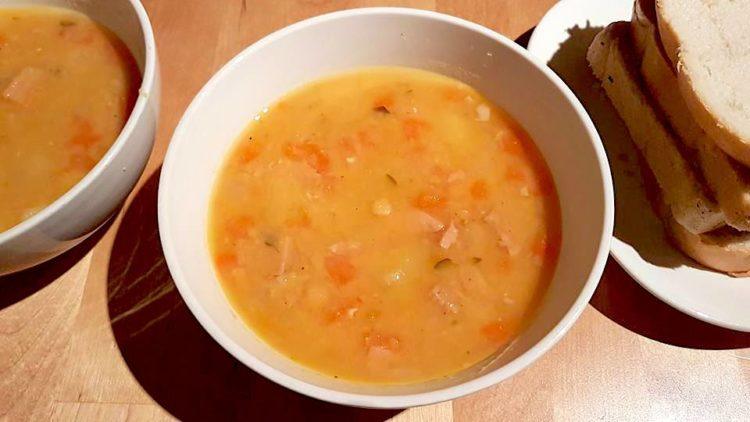
Every New Year, one of my grandmothers made a huge vat of what she
called “Scotch Broth”. Many other Northumbrian households did the
same, and the recipe is indeed based on a Scottish dish. This recipe
differs, however, because it contains no mutton or pearl barley.
Instead, I use ham – just as my grandmother did.
The yellow split peas are also a nod to the region, as the same pulses are used to make “pease pudding”, a speciality from North East England that is
generally served in sandwiches with ham. If possible, a locally sourced bread known as “stottie cake” is used to make the “sarnies” (as Geordies call them).
This makes more of a main meal that most soups. It’s a hearty repast
when served with lots of freshly baked, crusty bread and butter. My
grandmother made hers in a large stock pot rather than the slow
cooker, but I find it speeds things up to cook it that way. A bowl of
this, served steaming hot with plenty of bread and butter, revives
just about anyone who’s cold or hungry. Or even hungover from New
Year’s Eve…
contributed by: Tracy from Blogger by the Sea
Austrian Wienerschnitzel | RECIPE

When one hears Vienna, sausage is the word that probably comes next in mind. 😀 And it’s understandable, Vienna has been associated with the canned hotdog for so long. Ironically, the sausages in Vienna can be bought as street food, and in groceries if you fancy cooking. But to know Vienna through food, one has to try Tafelspitz, Wienerschnitzel, and Apfelstrüdel.
These three are also some of Austria’s national dishes. Tafelspitz may just be boiled veal meat, but it has been a favorite of Austria’s emperor Franz Joseph I, he always had it for his meals.
Wienerschnitzel, probably looks plain as would the Japanese Tonkatsu, or Milanesa, but it’s special because the meat used is veal, which is very tender and moist. It’s even under law that only schnitzel made from veal be called Wienerschnitzel. If made from other meats, this should be identified.
When you visit Vienna, try to go to a tavern by the outskirts where the vineyards are, and have a piece of Wienerschnitzel along with the tavern’s own wine. Guten Appetit!
contributed by: Gizelle from Vienna 101 Facets
Pad Thai | RECIPE
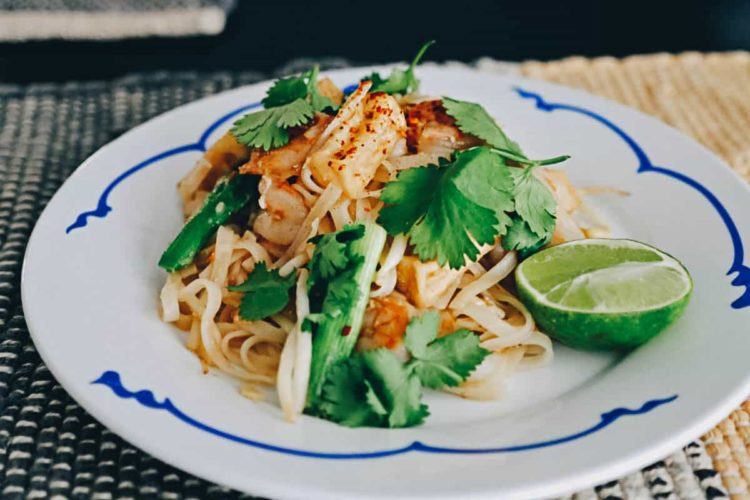
Pad Thai to me is like the gateway drug to Thai cuisine – it’s the first thing most people try. They visit Bangkok for the first time, they get a taste of pad thai and fall in love with it, then they start going for the harder stuff like larb and khao kluk kapi. It happens again and again.
Personally, this is what started my addiction to Thai food. Some Thai dishes can be challenging for the uninitiated but pad thai is that type of universally appealing dish that everyone likes.
Pad Thai is easy on the palate with its intriguing blend of sweet, savory, and sour. Fish sauce gives it a good kind of fishiness while chili flakes impart a touch of heat. Crunchy peanuts complement soft chewy noodles to create an aromatic balance of flavor and texture that’s appealing to all the senses.
There is so much to love about pad thai that I’ve rarely met one that I didn’t like. From the side streets of Bangkok to the beach resorts of Koh Samui, pad thai will reel you in and make you a lifetime lover of Thai cuisine.
contributed by: JB from Will Fly for Food
Persian Kashk e Bademjan | RECIPE

Kashk e bademjan is one of the most famous Persian dishes that combines some of the most exciting flavors from the Persian cuisine. While most Persian dishes are prepared with some sort of meat, this tasty eggplant dip is a delicious Persian vegetarian dish. Literally translated, it means kashk (a type of Persian yoghurt) and eggplant.
The preparation process for the dish is quite simple. The eggplants need to be peeled, seared and then cooked. Towards the end of the cooking process, the kashk yoghurt and typical Persian spices are added. These are typically saffron, turmeric and dried mint leaves.
Kashk e Bademjan is served hot and fresh with pita bread. Over the last years, the dish has become quite popular also outside of Iran and is often served in Middle Eastern restaurants on mezze platters. As most dishes in the Persian cuisine, kashk e bademjan is usually not served on its own but along with a number of other dishes.
contributed by: Mike from Persian Experts
Balinese Sambal Matah | RECIPE

Balinese cooking is full of wonderful flavours, with noodles, rice, fish, chicken and vegetable dishes- it’s sometimes hard to choose what to have! They also have side dishes and sauces called sambals which accompany most meals.
Sambals are chilli sauces or pastes from Indonesia usually made from a mix of chilli peppers blended with other ingredients like garlic, ginger, shallots, spring onions, lime juice, or shrimp paste.
When I visit Bali, I head to a warung for a mei goreng – fried noodles – served with my favourite side dish, sambal matah.
Sambal Matah, or lemongrass sambal, is a delicious raw Balinese accompaniment: sweet, sour, hot and cool with a lovely lemony hit all in one mouthful. Great with chicken, fish or vegetables, or any Balinese dish. Lemongrass grows abundantly in Bali, and if you can get it fresh it gives the dish extra zing.
It is very simple to make, with a lot of chopping involved, mix together then let it rest for about 30 minutes to let the flavors combine. It is best served fresh, but can keep overnight in the fridge.
contributed by: Larch from The Silver Nomad
Czech Goulash (Guláš) | RECIPE

Czech Goulash (Guláš) is one of the most typical Czech dishes. Same as other traditional Czech dishes like Svíčková or Vepřo Knedlo Zelo, Guláš is served with our most typical side dish – boiled or steamed bread dumplings. Guláš is usually made with beef or pork meat, it is a thick, hearty stew flavored primarily with paprika. It can be found on the menu of the vast majority of Czech restaurants.
Across the country, there are many variations of Guláš, and different families have slightly different Guláš recipes. Each cook can vary the experience by using different meats or adding other spices like caraway, pepper or marjoram. Guláš is often garnished with slices of fresh onion and is typically accompanied by beer. There are also variations of Guláš, like Goulash Soup or Szeged Goulash (or Segedín), which is cooked with cream and cabbage. The great thing about Guláš is that if you cook the whole pot of Guláš and have some leftovers for another day, it tastes even better reheated!
Czech cuisine is quite heavy but delicious. Basic flavors of Czech food are based in local agriculture – onion, garlic, caraway, and meat, for example, many Czech dishes have onion as a base
contributed by: Adriana from Czech The World
Peruvian Tallarines Verdes | RECIPE

Tallarines verdes, or green noodles, are like Peruvian pesto pasta – a tangible product of Italian immigrants in Peru, adapted to fit local ingredients and taste. It is creamier and milder than Italian pesto, because it uses more spinach than basil in the sauce and the garlic (also onion) is often sautéed before it all gets pureed.
Milk replaces olive oil as the blending liquid in some, if not all, of the recipes, and creamy cheese (like queso fresco or feta) takes the place of nutty Italian cheeses. It’s delicious, healthy, and straight out of Peru!
contributed by: Laura from Eat Your World
Which of these international travel recipes will you be trying out yourself?!





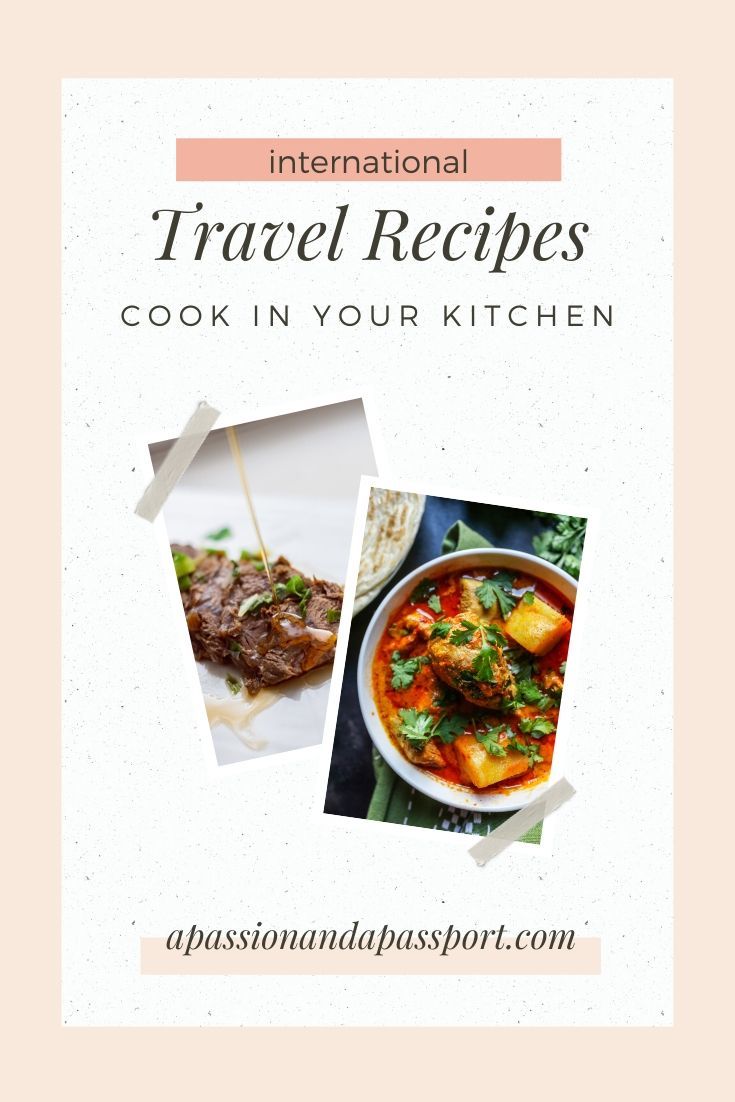






These all sound soooo good! I love the look of Peruvian Pollo a La Brasa and I have never even heard of Peruvian Tallarines Verdes, but I think I have made something like that before!
p.s. Yorkshire puddings always make the world better! 😉
Cool post. This is the beauty of travel isn’t it. It was my main reason for travel, the food! Living in Mexico and working with Mayans and locals here, I have also learnt so many recipes. They are the best when they are home made! Oh I loved the food in Bosnia too! Wasn’t what I expected actually.
Wow! These are all amazing, and I don't even know where to start trying recipes. Wonderful round up you've put together here.
My mouth is watering from reading your post! Each of these dishes look so good, and I love that they can easily be made dairy-free or gluten-free for those with food allergies like me. Thanks for sharing. Paella night here I come 🙂
Wow! I love street food like Brazilian Coxinhas. This is an amazing article to fall in love with food.
Wow! These are all amazing, and I don’t even know where to start trying recipes. Wonderful round-up you’ve put together here.